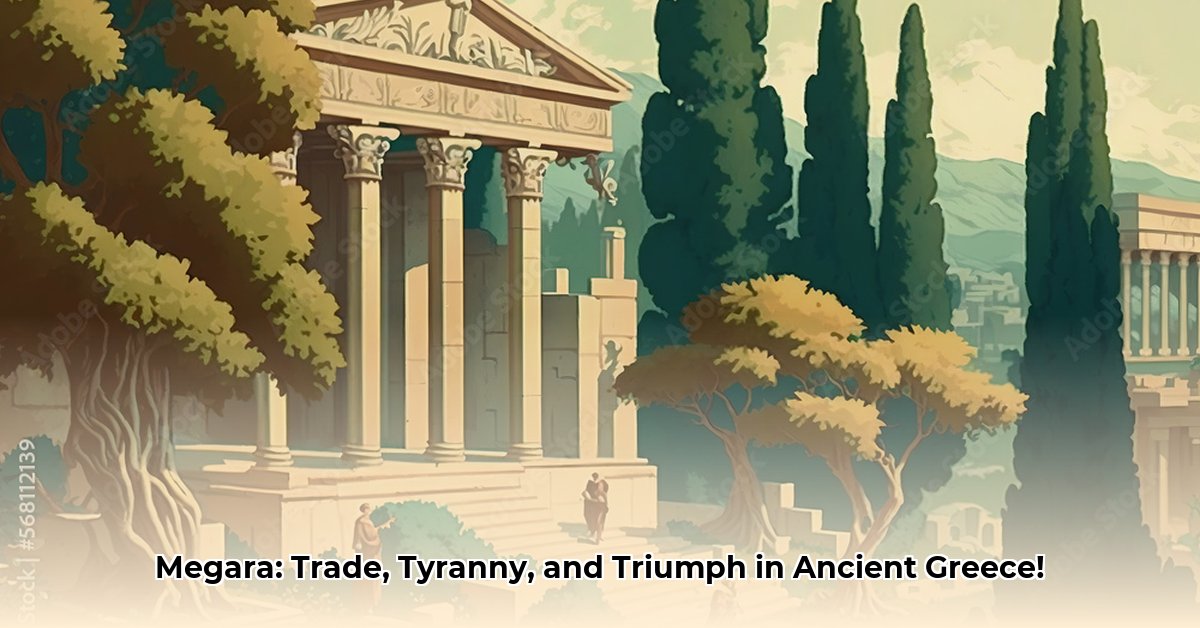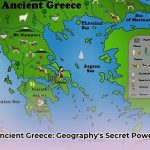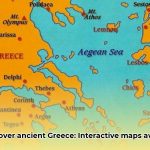Ancient Megara, a formidable city-state strategically nestled on the Isthmus of Corinth, played a far more pivotal and dynamic role in the tapestry of classical Greece than often recognized. More than a mere geographical transit point, this vibrant polis emerged as a nexus of trade, a relentless colonizer, a crucible for philosophical inquiry, and a persistent actor in the complex power struggles that defined its epoch. This comprehensive exploration delves into Megara’s unique geographical advantages, its far-reaching expansionist endeavors, its tumultuous yet enduring relationship with its powerful neighbors, and its lasting intellectual legacy, underscoring why its multifaceted story is indispensable to a complete understanding of the ancient Greek world. You can learn more about trade in ancient Greece.
The Strategic Heart: Megara’s Geographical and Formative Origins
Megara’s strategic brilliance and subsequent prosperity were intrinsically tied to its geography. Positioned on the narrow Isthmus of Corinth—a vital land bridge connecting the Peloponnese peninsula to mainland Greece—it naturally evolved into a crucial commercial artery. This unique location granted Megara control over essential land and sea routes, transforming it into a bustling hub where goods like textiles, olive oil, and pottery flowed, fostering profound cultural and economic interchange.
The city boasted two strategically vital harbors: Nisaea on the Saronic Gulf to the east and Pagae on the Corinthian Gulf to the west. This dual maritime access cemented Megara’s status as a formidable naval and trading power. Ships could either be hauled overland across the Isthmus on a paved trackway known as the Diolkos or utilize Megara as a central trading hub, effectively bypassing the perilous circumnavigation of the Peloponnese. This prime location generated considerable wealth but simultaneously rendered Megara an enticing target for rival city-states eager to dominate these lucrative trade arteries.
According to ancient Greek mythology, Megara’s origins are deeply rooted. Nisos, a son of King Pandion II of Athens, was said to be the mythical ruler of Megara, giving his name to the port Nisaea. The city’s name itself is often attributed to Car, son of Phoroneus, who supposedly built the citadel called ‘Caria’ and the temples of Demeter, referred to as ‘Megara.’ Archaeological evidence suggests Megara was a Mycenaean fortified site with a megaron, indicating it was once the seat of a petty king, though modern construction obscures many remains. Initially, Megara functioned as a dependency of Corinth, but it fiercely fought for its independence, establishing itself as a significant independent polis.
Global Reach: Megara’s Ambitious Colonial Empire
Megara’s ambitions extended far beyond its immediate territorial boundaries. The city actively pursued an extensive and systematic colonization strategy, spreading its influence and establishing vital economic and cultural outposts across the Mediterranean and Black Sea regions. This expansionist drive was a paramount element of its long-term strategy, securing access to new markets, resources, and strategic naval positions.
Megara’s colonial ventures unfolded through a methodical Strategic Outreach and Integration System:
- Strategic Site Selection: Megara meticulously identified key locations across the Mediterranean and Black Sea, prioritizing sites that offered control over critical trade routes, access to essential raw materials, or fertile agricultural lands.
- Founding of Key Colonies: The establishment of colonies such as Byzantium (modern-day Istanbul) in 667 BCE and Chalcedon in 685 BCE was a transformative act. Byzantium, specifically, situated at the mouth of the Bosporus Strait, evolved into a critical trade hub, linking the burgeoning economies of Europe and Asia. Other significant colonies included Megara Hyblaea in Sicily, founded in the 8th century BCE, and Heraclea in Bithynia, showcasing Megara’s diverse colonial interests.
- Economic Nexus Creation: These new settlements were not merely territorial acquisitions; they served as engines of economic growth, facilitating the large-scale movement of vital goods including grain, wine, olive oil, and textiles, thereby substantially boosting Megara’s commercial reach and wealth. Megara itself was famed for its wool and animal products.
- Cultural Dissemination: Beyond commerce, Megara actively disseminated its distinctive culture, language, and technologies, profoundly influencing the regions it colonized and contributing significantly to the broader Hellenization of the Mediterranean and Black Sea worlds. Megara also cultivated early ties with Miletos in Asia Minor, forming a “colonisation alliance” under the sanction of Apollo oracles, demonstrating a strategic and deeply rooted approach to its expansion.
While economically successful, the interactions between Megarian colonists and indigenous populations were often complex. For instance, archaeological findings at Megara Hyblaea indicate initial cooperation but ultimately reveal limited cultural mixing and a distinct lack of intermarriage, highlighting the inherent challenges and complexities of colonial endeavors despite their economic advantages. These ventures fundamentally cemented Megara’s role as a significant maritime power in the wider Greek world.
The Athenian Conundrum: Conflict, Sanctions, and Shifting Alliances
No comprehensive account of Megara is complete without examining its frequently strained and often volatile relationship with Athens. The two city-states were entangled in a perpetual rivalry over territory, particularly the island of Salamis, trade routes, and regional dominance—tensions that frequently escalated into direct confrontation.
The Megarian Decree: A Catalyst for War
The most infamous flashpoint in this rivalry was the Megarian Decree, enacted by Athens around 432 BCE. This drastic measure imposed severe economic sanctions on Megara, effectively prohibiting Megarian merchants from accessing Athenian markets and ports throughout its vast empire. This economic chokehold was devastating for Megara’s trade and overall prosperity, as its economy relied heavily on external commerce. The Athenians claimed this was in response to Megarian desecration of the Hiera Orgas, a sacred precinct on the border. Historians widely regard the Megarian Decree as a significant contributing factor, if not a direct cause, of the devastating Peloponnesian War (431–404 BCE), a protracted conflict that engulfed the entirety of the Greek world.
Megara’s alliances often shifted in response to this pressure. It notably defected from the Spartan-dominated Peloponnesian League around 460 BCE to join the Delian League (led by Athens) due to border disputes with Corinth. However, the terms of the Thirty Years’ Peace (446–445 BC) forced Megara to return to the Peloponnesian League, aligning it with Sparta during the Peloponnesian War. This constant maneuvering highlights the precarious position of smaller city-states caught between regional hegemons. During the war, Athens subjected Megara’s surrounding territory to subjugation, though the citadel itself famously resisted capture.
Internal Dynamics: The Ebb and Flow of Governance
The political landscape within Megara was far from static, characterized by frequent and sometimes violent shifts between different forms of government. The city experienced transitions between democracies and oligarchies, and even periods of tyrannical rule. These internal power struggles often stemmed from deep-seated factors such as economic inequality between rich and poor citizens and fierce competition among various social classes.
For instance, in the late 7th century BCE, Theagenes established himself as a tyrant by slaughtering the cattle of the rich to gain popular support. Megara experienced periods of democracy, notably between 427 BCE and 424 BCE, during which a democratic uprising occurred, and again in the 370s BCE, when anti-democratic conspirators were expelled. Key features of Megarian democracy included a popular Assembly, a Council, a board of generals, and the use of the secret ballot and ostracism. However, by the 350s BCE, Megara appears to have reverted to an oligarchy, concentrating power and wealth in the hands of a select few. This constant flux in governance undoubtedly impacted the lives of ordinary citizens, contributing to their political and economic uncertainty and often hampering Megara’s ability to maintain a consistent foreign policy or effectively respond to external threats.
Beyond Commerce and Conflict: Megara’s Enduring Intellectual and Cultural Legacy
Despite its tumultuous history of trade disputes and conflicts, Megara also distinguished itself as a vital center of intellectual and cultural inquiry. The city is particularly renowned for the Megarian School of Philosophy, founded by Euclid of Megara (distinct from the famed mathematician), a prominent student of Socrates. Flourishing for approximately a century from the early 4th century BCE, this school became a significant force in ancient Greek thought, primarily focusing on logic, dialectics, and metaphysics. The Megarian philosophers were celebrated for their rigorous arguments, their unwavering commitment to logical precision, and their exploration of paradoxical arguments, profoundly influencing later philosophical traditions, including Stoicism.
Beyond philosophy, Megara also boasts other notable historical figures. Byzas, the legendary founder of Byzantium in the 7th century BCE, was a native Megarian. The esteemed 6th-century BCE elegiac poet Theognis also hailed from Megara, contributing to the rich literary heritage of the Hellenic world. Furthermore, Herodicus, considered the father of sports medicine in the 5th century BCE, famously prescribed walking from Athens to Megara to his patients, marking one of the earliest known instances of exercise prescribed for health.
The Megarians were also renowned for their piety and generosity in constructing and endowing temples. The saying, “They build as if they are to live forever; they live as if they are to die tomorrow,” attributed to Saint Jerome, eloquently captures their paradoxical blend of long-term vision and present-moment intensity. However, another ancient Greek proverb, “worthy of the Megarians share,” was used to imply dishonor, suggesting a complex societal perception of the city-state.
Megarian Resilience and Later History
Megara’s strategic location ensured its continued relevance through successive historical periods. During the Celtic invasion of 279 BCE, Megara dispatched a force of 400 peltasts (light infantrymen) to Thermopylae. In 266 BCE, during the Chremonidean War, the Megarians famously defended themselves against Macedonian king Antigonus Gonatas, reportedly using “burning pigs” to rout his war elephants—a testament to their ingenious and tenacious defense. Despite this remarkable success, they eventually submitted to Macedonian rule.
Their allegiances continued to shift. In 243 BCE, urged by Aratus of Sicyon, Megara expelled its Macedonian garrison and joined the Achaean League. However, when the Achaeans lost control of the Isthmus in 223 BCE, Megara temporarily joined the Boeotian League, only to return to the Achaean League within thirty years, weary of Boeotian decline. Even in the Roman period, Megara faced challenges. Plutarch recounts a vivid and tragic episode during a Roman siege around 48 BCE, where Megarians attempted to unleash lions against Quintus Fufius Calenus’s troops, only for the animals to prey on the unarmed citizens themselves.
Enduring Echoes: Lessons from Ancient Megara’s Story
The captivating story of ancient Megara, though often overshadowed by the narratives of Athens or Sparta, offers profound insights into the intricate dynamics of the ancient Greek world. Megara’s narrative serves as a compelling case study on the interplay of geography, robust trade networks, ambitious colonization, internal political volatility, and external conflict in shaping a city-state’s destiny.
Ongoing archaeological research continues to shed new light on various facets of Megara’s history, from its extensive trade networks clarified by new finds to the true cultural impact of its colonies in the Black Sea region. The enduring legacy of this strategically vital city provides invaluable lessons for modern understanding of ancient geopolitics and economic warfare. The Megarian Decree, for instance, stands as a prime historical example of economic warfare, illustrating how sanctions can achieve political aims but also ignite unforeseen and severe consequences. The resilience demonstrated by ancient Greek societies in the face of such conflicts underscores their adaptability and enduring contributions to civilization. Megara’s narrative reinforces the enduring relevance of studying history to inform contemporary issues, providing a cautionary tale regarding the potential for escalation arising from local disputes. From its mythical origins and rise as a trade giant to its philosophical contributions, its ingenious defenses, and its complex political evolution amidst powerful rivalries, Megara’s multifaceted story truly encapsulates the dynamic essence of ancient Greek civilization.
- Unearth ancient rome achievements: Engineering feats & legal legacies, examined - August 13, 2025
- Unlock ancient rome army ranks: Power, impact & legion command - August 13, 2025
- Conquer Your Exam: Ancient Greece Quiz Ace It Now! - August 13, 2025
















